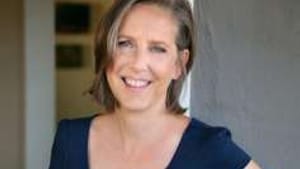Stay in the Loop
BSR publishes on a weekly schedule, with an email newsletter every Wednesday and Thursday morning. There’s no paywall, and subscribing is always free.
There's something about Mary
Mary Roach cruises the alimentary canal

A dear friend of mine had major back surgery last year, and, unable to go out or even read because of the side effects of her medicine, she asked me to read to her.
My friend wanted Mary Roach— and of course she insisted on hearing the part about urinating and defecating in zero gravity.
Such are the delights and pitfalls of sharing Mary Roach, who joyfully mines human taboos the way dour memoirists mine their childhoods.
In Stiff: The Curious Lives of Human Cadavers, Roach chases dead bodies from plastic surgery school to forensic labs. Her Spook: Science Tackles the Afterlife explores efforts to prove or disprove the existence of the afterlife. Roach studies the study of sex in Bonk: The Curious Coupling of Science and Sex. And her next book, Packing for Mars: The Curious Science of Life in the Void, discovers the human bodies that are discovering space.
"The human body is kind of a weird, strange planet, and lots of interesting things go on there that I am endlessly fascinated by," Roach told me in an interview last year.
The Mütter's mega-colon
The tour for her latest book, Gulp: Adventures on the Alimentary Canal, brought Roach to the Free Library of Philadelphia last week for a conversation with Mütter Museum curator Anna Dhody, who couldn't have asked for a better chance to tout the Mütter's "megacolon," obtained from a victim of Hirschsprung disease. At the time of the unfortunate Mütter donor's death, his malfunctioning colon contained more than 40 pounds of . . . you get the idea.
The audience of Mary Roach fans also appreciated her discussion on the unfortunate coincidence of Brussels sprouts season and weather so cold that you keep your head under the covers, with the malodorous result dubbed either a "Dutch oven" or a "covered wagon," depending on what side of the Mississippi you live on.
Roach also illuminated "careers dedicated to saliva" (one saliva lab owns, of course, "the world's largest paper-towel holder"), and the pressing question of why the muscular sack of hydrochloric acid known as our stomach doesn't digest itself. (The answer is that it does, but the lining of your stomach is constantly regenerating.)
Our debt to bacteria
Roach also touched on the burgeoning field of biomass ("It sounds almost religious"), which teaches us that for every one human cell we possess, we have nine cells of "otherness." She said bacteria and other microbes happily living in and on our bodies account for a few pounds of our total weight— and we'd be dead without them. So of course, the question is, "Who owns whom?"
Or, in other words, as Roach happily phrased it, "Your gas is their gas."
The discussion also included a revolutionary medical treatment for a serious intestinal disorder that affects tens of thousands of people every year. The Clostridium difficile bacterium doesn't normally pose a threat to our bellies, but when a wanton antibiotic destroys the gut's normal microscopic community, it can flourish and make us sick. Researchers struggled to cure the disease, until a better understanding of our intestinal flora led to the use of fecal transplantation.
Yes, medically screened donor feces are blended into a liquid and piped into the patient's ailing intestines. This radically simple re-introduction of healthy gut bacteria results in astonishing cure rates for this previously intractable disease.
Too much information?
Roach and Dhody explained that the "ick factor" of this treatment isn't the only thing keeping it from mainstream use. Since no profitable drugs or devices are involved (just some free feces), Big Pharma isn't interested in promoting the procedure, notwithstanding the high success rate.
Still, you can decide for yourself if, as Roach said at the Free Library, "there's no downside" to this unprecedented use of excrement.
Roach took many questions from the audience, gaily expounding on normal intestinal "storage capacity" and what aspect of her Gulp research was Too Much Information, even for her: a non-sedated colonoscopy.
After the discussion, the line to get books autographed was so long that I read the first 62 pages of Gulp while waiting, and then continued to devour it on the train home. In Gulp, Roach works a stint as an olive-oil taster, visits a dog-food taste-testing facility, and recounts the shenanigans of the self-styled nutritional scientist Horace Fletcher, who, in the early 20th Century, sparked a mastication fad that claimed human beings could radically reduce the amount of food they needed to survive if they just chewed each bite hundreds of times.
A date with Mary?
While waiting to get my book signed, I eavesdropped on the desultory flirtation of two recent law school grads behind me. The man speculated that Mary Roach was probably someone he'd never want to take on a date— what with all the zany things she's done for her books, she could one-up everything you said.
Having interviewed her last year, I could have told him that Roach is actually a warm and genuinely entertaining person, on the page and off. Why else would she have personally responded to an out-of-the blue interview request from an unknown writer?
"Gassily yours," she scrawled on my title page.♦
To read a response, click here.
My friend wanted Mary Roach— and of course she insisted on hearing the part about urinating and defecating in zero gravity.
Such are the delights and pitfalls of sharing Mary Roach, who joyfully mines human taboos the way dour memoirists mine their childhoods.
In Stiff: The Curious Lives of Human Cadavers, Roach chases dead bodies from plastic surgery school to forensic labs. Her Spook: Science Tackles the Afterlife explores efforts to prove or disprove the existence of the afterlife. Roach studies the study of sex in Bonk: The Curious Coupling of Science and Sex. And her next book, Packing for Mars: The Curious Science of Life in the Void, discovers the human bodies that are discovering space.
"The human body is kind of a weird, strange planet, and lots of interesting things go on there that I am endlessly fascinated by," Roach told me in an interview last year.
The Mütter's mega-colon
The tour for her latest book, Gulp: Adventures on the Alimentary Canal, brought Roach to the Free Library of Philadelphia last week for a conversation with Mütter Museum curator Anna Dhody, who couldn't have asked for a better chance to tout the Mütter's "megacolon," obtained from a victim of Hirschsprung disease. At the time of the unfortunate Mütter donor's death, his malfunctioning colon contained more than 40 pounds of . . . you get the idea.
The audience of Mary Roach fans also appreciated her discussion on the unfortunate coincidence of Brussels sprouts season and weather so cold that you keep your head under the covers, with the malodorous result dubbed either a "Dutch oven" or a "covered wagon," depending on what side of the Mississippi you live on.
Roach also illuminated "careers dedicated to saliva" (one saliva lab owns, of course, "the world's largest paper-towel holder"), and the pressing question of why the muscular sack of hydrochloric acid known as our stomach doesn't digest itself. (The answer is that it does, but the lining of your stomach is constantly regenerating.)
Our debt to bacteria
Roach also touched on the burgeoning field of biomass ("It sounds almost religious"), which teaches us that for every one human cell we possess, we have nine cells of "otherness." She said bacteria and other microbes happily living in and on our bodies account for a few pounds of our total weight— and we'd be dead without them. So of course, the question is, "Who owns whom?"
Or, in other words, as Roach happily phrased it, "Your gas is their gas."
The discussion also included a revolutionary medical treatment for a serious intestinal disorder that affects tens of thousands of people every year. The Clostridium difficile bacterium doesn't normally pose a threat to our bellies, but when a wanton antibiotic destroys the gut's normal microscopic community, it can flourish and make us sick. Researchers struggled to cure the disease, until a better understanding of our intestinal flora led to the use of fecal transplantation.
Yes, medically screened donor feces are blended into a liquid and piped into the patient's ailing intestines. This radically simple re-introduction of healthy gut bacteria results in astonishing cure rates for this previously intractable disease.
Too much information?
Roach and Dhody explained that the "ick factor" of this treatment isn't the only thing keeping it from mainstream use. Since no profitable drugs or devices are involved (just some free feces), Big Pharma isn't interested in promoting the procedure, notwithstanding the high success rate.
Still, you can decide for yourself if, as Roach said at the Free Library, "there's no downside" to this unprecedented use of excrement.
Roach took many questions from the audience, gaily expounding on normal intestinal "storage capacity" and what aspect of her Gulp research was Too Much Information, even for her: a non-sedated colonoscopy.
After the discussion, the line to get books autographed was so long that I read the first 62 pages of Gulp while waiting, and then continued to devour it on the train home. In Gulp, Roach works a stint as an olive-oil taster, visits a dog-food taste-testing facility, and recounts the shenanigans of the self-styled nutritional scientist Horace Fletcher, who, in the early 20th Century, sparked a mastication fad that claimed human beings could radically reduce the amount of food they needed to survive if they just chewed each bite hundreds of times.
A date with Mary?
While waiting to get my book signed, I eavesdropped on the desultory flirtation of two recent law school grads behind me. The man speculated that Mary Roach was probably someone he'd never want to take on a date— what with all the zany things she's done for her books, she could one-up everything you said.
Having interviewed her last year, I could have told him that Roach is actually a warm and genuinely entertaining person, on the page and off. Why else would she have personally responded to an out-of-the blue interview request from an unknown writer?
"Gassily yours," she scrawled on my title page.♦
To read a response, click here.
What, When, Where
Gulp: Adventures on the Alimentary Canal. By Mary Roach. W.W. Norton, 2013. 352 pages; $26.95. www.amazon.com.
Sign up for our newsletter
All of the week's new articles, all in one place. Sign up for the free weekly BSR newsletters, and don't miss a conversation.
 Alaina Johns
Alaina Johns